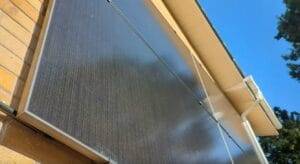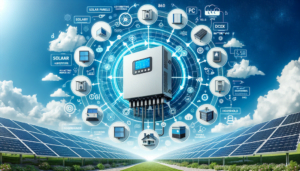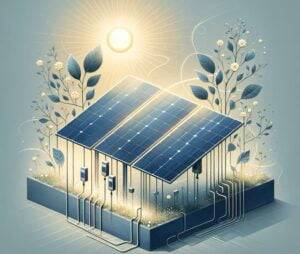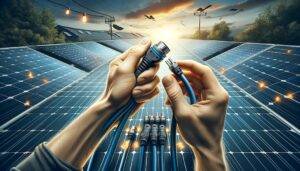Choose a suitable solar inverter for optimal performance of your solar energy system. Explore microinverters, string inverters, and hybrid inverters.
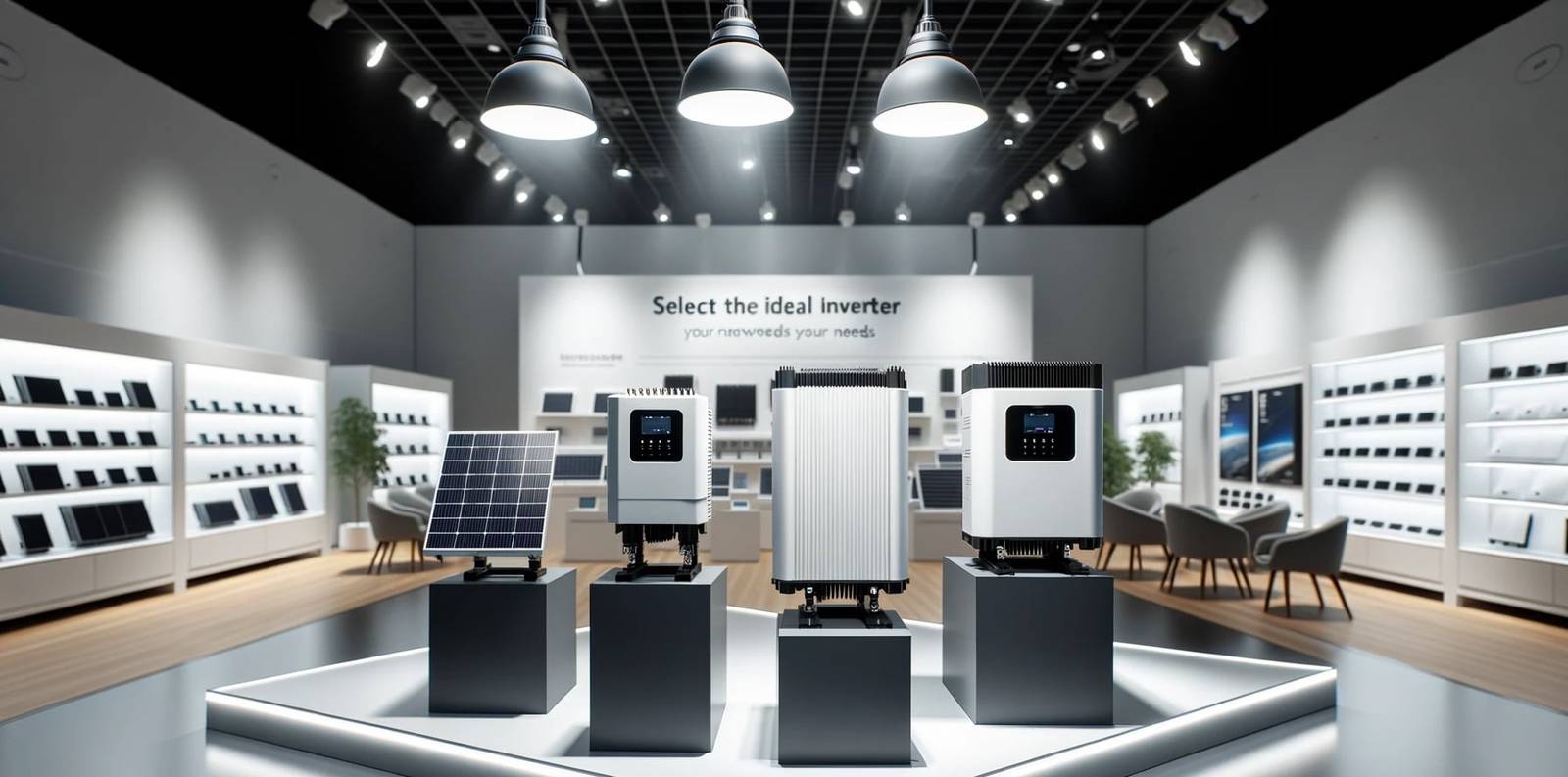
Selecting the inverter for your home solar energy system is a strategic decision. The time you spend researching this topic will pay off.
Find the Right Inverter For Your Home
Use this interactive infographic to find out what might be the right inverter for your home based on your needs and the characteristics of the inverter types.
blockquote {}figure { text-align: center; }figure img { margin: 0 auto; display: block; }.logo { height: 42px; width: 42px; margin-right: 10px; }.sectionlinksFont { font-family:var(–bs-font-sans-serif) }.contents { font-family: “Josefin Sans”,sans-serif; font-weight: 500; line-height: 1.2; font-size: calc(1.29rem + .48vw); }.fit-container { max-width: 100%; height: auto; width: auto; }/* Bottom menu*/ /* Base styles for section links font */ .sectionlinksFont { /* Set a default font-size, adjust as needed */ font-size: 16px; }/* As the screen gets smaller, the font size decreases */ @media (min-width: 992px) { .sectionlinksFont { font-size: 16px; /* Default font size for desktops */ } }@media (min-width: 768px) and (max-width: 991px) { .sectionlinksFont { font-size: 14px; /* Slightly smaller font size for tablets */ } }@media (max-width: 767px) { .sectionlinksFont { font-size: 12px; /* Even smaller font size for large phones */ } }@media (max-width: 576px) { .sectionlinksFont { font-size: 10px; /* Smallest font size for small phones */ } }.sectionlinksFont { /* Starts at 10px and scales up slightly as the viewport width increases */ font-size: calc(10px + 0.5vw); /* Adjust the base size and scaling factor as needed */ }.myn2 { margin-top: -0.5em; }.extraSmall { font-size: 0.70em; }.xxSmall { font-size: 0.7em; }.title-font-display { font-weight: 900; /* Makes the font bolder */ font-size: calc(4.375rem + 1.5vw); font-weight: 300; line-height: 1.2; -webkit-text-stroke: 0.01rem #b02a37; }.anchor { visibility: hidden; opacity: 0; transition: visibility 0s, opacity 0.5s linear; }h1:hover .anchor, h2:hover .anchor, h3:hover .anchor, h4:hover .anchor, h5:hover .anchor, h6:hover .anchor { visibility: visible; opacity: 1; } /* See also links */ .article-link { display: flex; /* Establishes a flex container */ align-items: center; /* Vertically centers the items in the flex container */ text-decoration: none; /* Optional: Removes underline from the link */ color: inherit; /* Optional: Inherits text color from parent */ }.article-thumbnail { max-width: 100px; max-height: 60px; width: auto; /* Width can be auto to maintain aspect ratio */ height: auto; /* Height can be auto to maintain aspect ratio */ margin-right: 10px; /* Adds some space between the image and the text */ border-radius: 4px; /* Optional: rounds the corners for a softer look */ box-shadow: 0 2px 4px rgba(0,0,0,0.1); /* Optional: adds a subtle shadow for depth */ }.article-title { font-size: 1.2em; /* Adjust the size as necessary */ margin: 0; /* Removes default margins */ } /*End of See Also*/.card { box-shadow: 0 4px 6px rgba(0,0,0,.1); transition: transform .3s ease-in-out, box-shadow .3s ease-in-out; }.card:hover { transform: translateY(-1px); box-shadow: 0 10px 15px rgba(0,0,0,.2); }.card-img-top { width: 100%; /* Full width of the card */ max-height: 200px; /* Maximum height is set to 400px */ object-fit: cover; /* It will cover the area without distorting the aspect ratio */ }.card-body { flex-grow: 1; /* This will make the body take up all available space pushing the footer down */ /*height: 295px; !* Maximum height is set to 400px *!*/ }.card-title a { text-decoration: none; }.card-title a:hover { text-decoration: underline; }.card-footer { border-top: 1px solid #e9ecef; padding: 0.5rem; /* Flexbox properties are not needed here if we just want the footer to stick to the bottom */ }.card-footer svg { width: 1em; height: 1em; vertical-align: middle; }.card-footer .metadata { /*display: flex;*/ justify-content: center; /* Or ‘space-between’ for edge-to-edge alignment */ gap: 0.5rem; /* Adjust as needed */ align-items: center; }.card-footer .metadata > span { white-space: nowrap; }/* Optional: hide overflow text with ellipsis */ .card-footer .metadata > span { overflow: hidden; text-overflow: ellipsis; }/*inverter choice*/ .wiz-body { font-family: ‘Arial’, sans-serif; line-height: 1.6; color: #333; max-width: 800px; margin: 0 auto; padding: 20px; background-color: #f0f8ff; } .wiz-container { background-color: #ffffff; border-radius: 10px; padding: 20px; box-shadow: 0 0 10px rgba(0,0,0,0.1); }.step { display: none; animation: fadeIn 0.5s; } @keyframes fadeIn { from { opacity: 0; } to { opacity: 1; } } .btn { background-color: #3498db; color: white; border: none; padding: 10px 20px; margin: 5px; border-radius: 5px; cursor: pointer; transition: background-color 0.3s; } .btn:hover { background-color: #2980b9; } .icon { font-size: 48px; color: #3498db; margin-bottom: 20px; } .info-panel { border-left: 5px solid #3498db; padding: 10px; margin-top: 20px; display: none; } #recommendation { background-color: #d4edda; border-color: #c3e6cb; color: #155724; padding: 15px; border-radius: 5px; margin-top: 20px; text-align: center; } #comparison-table { width: 100%; border-collapse: collapse; margin-top: 20px; } #comparison-table th, #comparison-table td { border: 1px solid #ddd; padding: 8px; text-align: left; } #comparison-table th { background-color: #f2f2f2; }/* New styles for breadcrumb and restart button */ .breadcrumb { display: flex; list-style: none; padding: 0; margin-bottom: 20px; } .breadcrumb li { margin-right: 10px; } .breadcrumb li:not(:last-child):after { content: ‘>’; margin-left: 10px; color: #6c757d; } .breadcrumb li a { color: #3498db; text-decoration: none; cursor: pointer; } .breadcrumb li.active { color: #6c757d; } #restart-btn { background-color: #fed481; float: right; } .icon { color: #fed481; /* Soft yellow color */ }Shading can significantly impact the performance of your solar array. Microinverters or power optimizers can help mitigate the effects of partial shading.
A complex roof might have multiple angles, orientations, or obstructions. This can affect the layout and efficiency of your solar panels.
While string inverters are typically the most cost-effective option, microinverters or power optimizers might offer better long-term value in certain situations.
If you’re considering future expansion, microinverters or a larger string inverter with the capacity for additional panels might be the best choice.
If you’re considering adding battery storage, a hybrid inverter might be the most suitable option as it’s designed to work with both solar panels and batteries.
| Feature | String Inverter | Microinverter | Hybrid Inverter |
|---|---|---|---|
| Cost | Low | High | Medium |
| Efficiency | Good | Excellent | Very Good |
| Shading Tolerance | Poor | Excellent | Good |
| Battery Compatible | No | No | Yes |
| Scalability | Limited | Excellent | Good |
The Key Information For An Informed Decision
Your primary considerations will revolve around factors such as:
- The jobs your inverter will perform:
- charge a battery
- grid-tied or off-grid
- will it limit export
- Physical space availability
- Power Output requirements
Other equally important factors are your home demand, export conditions, and the size of the solar array.
Additionally, local building regulations and certification processes may apply and restrict your choice.
What is the Best Type of Inverter – Hybrid, String, or Microinverter?
The answer is simple: it depends.
Generally, all of these inverter types will convert DC to AC. Each type has its strengths and weaknesses. Based on your system and the circumstances in which it operates, one of these will always be better.
So, let’s explore these common types of solar inverters:
- Microinverters
- Basic string inverters
- Feature-rich hybrid invertershttps://www.youtube.com/embed/McePCl6rDi4?autoplay=0&controls=1&end=0&loop=0&mute=0&start=0
Feature-rich Hybrid Inverters
Hybrid inverters are versatile and have useful built-in features such as advanced monitoring, extensive customisation options, a built-in Battery Management System (BMS), island mode and Generator port inputs. These inverters can come with serious power conversion capabilities from a domestic usage point of view. The typical range is 2-12kW, with 3.6kW, 5kW and 8kW being particularly popular choices for domestic users due to their close match of peak domestic power usage requirements and limited solar array capacity.
- Advanced monitoring makes it easy to understand how the sun conditions and your home energy consumption influence each other. It also gives valuable insight into battery State Of Charge (SOC) and energy export metrics.
- Extensive customisation options allow owners to configure the inverter’s behaviour and priorities. For example, you can set the order of priorities for distributing solar energy. Typically, this looks like home consumption first, then battery charge, then grid export. This means if your solar panels produce enough energy to match your home’s consumption, you can use the excess to charge the batteries. When the batteries are charged, you can export the excess to the grid. The inverter manages all of that.
- Built-in BMS lets the inverter balance its energy allocation by supplementing its energy mix with energy from the solar panels and batteries when needed or storing excessive solar energy in the batteries directly. The inverter can also charge the batteries with power from the grid if configured to do so and also export power from the batteries to the grid. These feature are particularly useful when flexible energy tariffs are available. See this article on battery without solar panels for more details.
- Island mode (or Grid-Isolated Mode): In this mode, the inverter can operate independently of the grid, creating its own “island” of power. This can happen either when the grid is down or during intentional disconnection from the grid. The inverter ensures that the connected loads continue receiving power from the solar panels or from stored energy in batteries. In island mode, the inverter manages the isolated grid’s power quality, frequency, and voltage. Wikipedia offers a deep dive into islanding .
- Generator ports are another useful feature of hybrid inverters. These can be used to plug wind turbines, power generators, i.e. petrol or diesel-powered generators or even AC from other inverters. These auxiliary sources are particularly useful as a backup when running off-grid. The use case for plugging converted electricity is also quite useful as an expansion to the existing system where no spare ports are left in the string inverters.
Microinverters
Microinverters take DC input from one or two panels. They convert it to AC output with a voltage rating for local consumers. For example, in the UK, microinverters will output AC at 230V, and in the US, at 110V.
Here is an example of a microinverter. As you can see, its dimensions are small enough, and it comes with built-in clips that let you easily place it on the back of a solar panel.
Advantages of using microinverters:
- Complex Layouts: When solar panels in a single cannot face in the same direction. In such cases, microinverters allow for flexibility by converting output from individual panels and maximising the productivity of your array.
- Shading Issues: If some panels in your array might experience shading during parts of the day (due to trees, chimneys, or other obstructions) then the performance of the entire string drops. Microinverters mitigate this problem because each panel operates independently.
- Scalability: Want to start small and expand your solar setup later? Microinverters make this easy. You can add more panels (each with its microinverter ) to the system without replacing or upgrading a central inverter.
- Safety: Microinverters convert DC to AC right at the panel. This means DC doesn’t travel across your roof, reducing potential fire hazards and ensuring safer maintenance and repair.
- Monitoring: Many microinverters come with advanced monitoring capabilities. You can monitor the performance of each panel, making it easier to detect and address any issues.
- Longevity: Microinverters often come with longer warranties than traditional string inverters. While a typical string inverter might have a warranty of 10-15 years, many microinverters boast warranties of 20-25 years.
- Installation Simplicity: With their compact size and design tailored for individual panels, microinverters can simplify installation, especially for smaller solar setups or DIY enthusiasts. Or you can connect their output as an additional string into the Generator port of a hybrid inverter. Expanding into the generator port is a viable way to upgrade your solar capacity when all the MPPTs of the inverter are taken.
 Configuring a hybrid inverter to take input from microinverters. Credit: USER MANUAL SUNSYNK-3.6K-SG01LP1 / SUNSYNK-3.6K-SG03LP1 / SUNSYNK-5K-SG01LP1 / SUNSYNK-5K-SG03LP1
Configuring a hybrid inverter to take input from microinverters. Credit: USER MANUAL SUNSYNK-3.6K-SG01LP1 / SUNSYNK-3.6K-SG03LP1 / SUNSYNK-5K-SG01LP1 / SUNSYNK-5K-SG03LP1
When to avoid microinverters
Sometimes, you don’t need a microinverter; a simple string inverter will suffice. Another reason to avoid them is if access to the panels is difficult. For example, if you have to hire special equipment to reach your panels, you may regret placing the inverters near them in case of faults.
In order to comply with G98/G99 regulations in the UK, microinverter systems require monitoring device to commission the system. Furthermore, the monitoring device needs remain on site permanently.
Basic String Inverters
String inverters are straightforward and uncomplicated. They take various size strings of solar panels and convert DC to AC.
These inverters come in various sizes and capabilities and fit any budget and system of almost any size.
Their versatility and cost make them an indispensable building block in home solar energy systems.
To illustrate the versatility of these inverters, have a look at the string inverter product line from Growatt.
| Datasheet | MIC 750TL-X | MIC 1000TL-X | MIC 1500TL-X | MIC 2000TL-X | MIC 2500TL-X | MIC 3000TL-X | MIC 3300TL-X |
|---|---|---|---|---|---|---|---|
| Max. recommended PV power (for module STC) | 1050W | 1400W | 2100W | 2600W | 2800W | 3500W | 4290W |
| Max. DC voltage | 500V | 500V | 500V | 500V | 550V | 550V | 550V |
| Start voltage | 50V | 50V | 50V | 50V | 80V | 80V | 80V |
| Nominal voltage | 120V | 180V | 250V | 360V | 360V | 360V | 360V |
| MPP voltage range | 50V-500V | 50V-500V | 50V-500V | 50V-500V | 65V-550V | 65V-550V | 65V-550V |
Source: Growatt Datasheet MIC750~3300TL-X
One of the highlights here is the low start voltage. Only 50V means you can have one or two panels and still produce AC. In contrast, many of the feature-rich hybrid inverters require at least 100V.
Of course, cost optimisation comes at the expense of some advanced features and conveniences. Some such features include advanced monitoring, complex configurations, or a built-in Battery Management System (BMS).
When Are Basic String Inverters Not For You?
Some of the lower power rating string inverters have similar ratings as microinverters. If space is an issue or you don’t have a place shielded from the elements, you are better off with a microinverter.
Additionally, if you plan to introduce batteries to your system, you should invest in a hybrid inverter straight away.
How to Select a Solar Inverter?
Choosing the inverter requires careful evaluation of your requirements and constraints. It can be one of the most expensive single parts of a solar energy system. Therefore, future changes in these requirements and constraints must be considered as much as possible to predict.
Choosing an Inverter Based on Voltage
Inverters have two key voltage specifications worth noting – the start-up voltage and the maximum load voltage.
The startup voltage is the threshold that needs to be achieved by your solar array for the inverter to start producing AC. For example, if your invert’s start-up voltage is 125V and you have a string of three panels of 35V each connected in series. In optimal conditions, your solar array will reach a maximum of 105V, which is insufficient for the inverter. To rectify this, we need at least one more panel. Then, the combined voltage will be 140V, and the inverter will start producing AC.
The inverter specification lists the maximum voltage. It is essential to stay within it. The best value to aim for in the inverter specifications is the MPPT Voltage Range.

Exceeding the voltage can result in smoke or fire from your inverter. It is important to stay within the limit.
How do I Calculate the Voltage of My Array?
You need to take the technical specification of your panels and calculate the voltage based on the values there, and the size of your string and it’s connection specifics. See Solar String Expansion. Panels Connection Parallel vs Series for more details on how string voltage, current and power vary with the different connections.

What do I Choose First, the Inverter or the Panels?
The answer is it depends.
Suppose you have insufficient space for a large solar array, and your inverter’s main job will be to work with a large battery. In such a case, choose the inverter first.
On the other hand, if you are installing a large solar array or multiple string, the inverter must match that and the use cases you plan for this array.
Bear in mind that you cannot upgrade a solar inverter. Think strategically about potential future expansions, and it will pay off well.
Other Concerns When Choosing the Inverter
Except for the technical and practical aspects, there are also administrative and physical concerns.
UK Solar Inverter Regulations
In Britain, solar inverters must be registered with the local Distribution Network Operators (DNOs). DNOs are licensed companies that own and operate the network of towers, transformers, cables and meters that carry electricity from the national transmission system and distribute it throughout Britain. At the time of writing this article, DNOs can accept or refuse a request to connect a solar inverter to the grid. The process happens with notification forms G-98 and G-99. DNOs require inverters to be tested and accepted by the Energy Networks Association ENA – list of compliant devices .
When researching components for your system, always check that the inverter you picked is in the ENA list of compliant devices.
Solar Inverter Size and Space Requirements
Physical constraints such as suitable free space for your inverter can become challenging if not thought through early enough. Hybrid inverters are packed with components that generate heat or are sensitive to extreme conditions such as cold or direct sunlight.
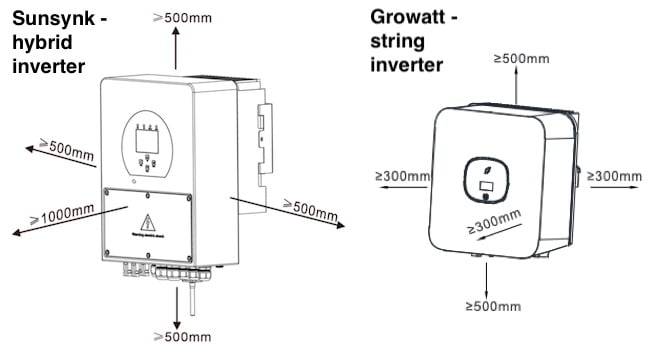
Most feature-rich hybrid inverters require a clear space of 40-50cm on each side of the inverter to ensure fresh air circulation to the cooling elements is not obstructed. Also, most cannot be installed directly outdoors without some degree of protection from the elements. Microinverters are way less demanding in that area.
Conclusion
In conclusion, selecting the right solar inverter—a microinverter, string inverter, or hybrid inverter— is a critical decision for homeowners venturing into solar energy. Microinverters offer individual panel optimisation and easy scalability, while basic string inverters serve larger arrays efficiently. Hybrid inverters provide the best of both worlds with advanced features, accommodating batteries and intelligent energy management. Your choice must align with your space, power needs, and long-term energy goals. At the same time, you still have to ensure your choice adheres to local regulations. Embrace the future by choosing wisely, and your solar system will deliver optimal performance for years to come.

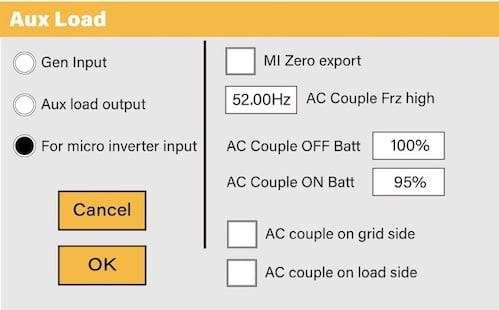 Configuring a hybrid inverter to take input from microinverters. Credit: USER MANUAL SUNSYNK-3.6K-SG01LP1 / SUNSYNK-3.6K-SG03LP1 / SUNSYNK-5K-SG01LP1 / SUNSYNK-5K-SG03LP1
Configuring a hybrid inverter to take input from microinverters. Credit: USER MANUAL SUNSYNK-3.6K-SG01LP1 / SUNSYNK-3.6K-SG03LP1 / SUNSYNK-5K-SG01LP1 / SUNSYNK-5K-SG03LP1